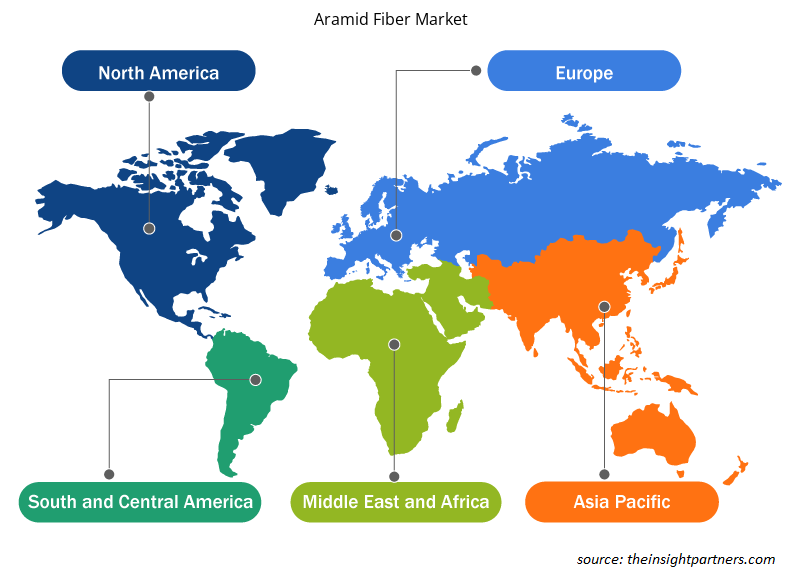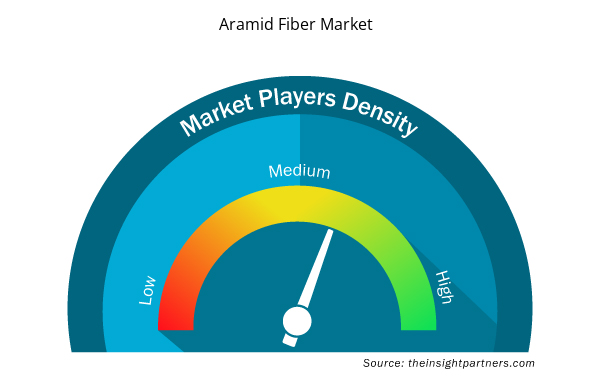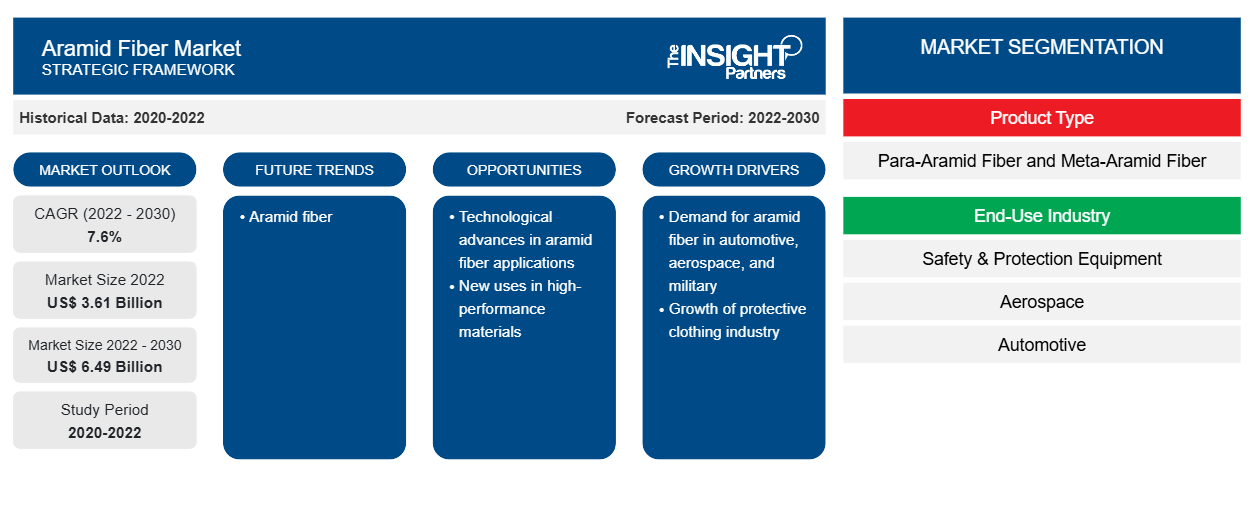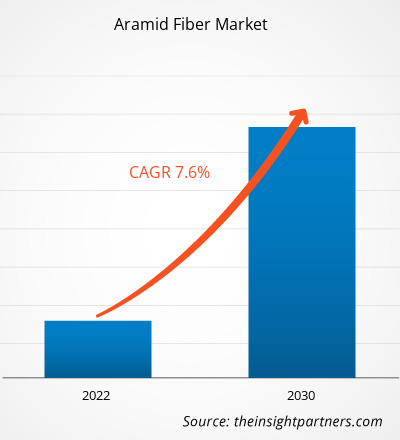[Forschungsbericht] Der Markt für Aramidfasern hatte im Jahr 2022 einen Wert von 3,61 Milliarden US-Dollar und soll bis 2030 6,49 Milliarden US-Dollar erreichen; von 2022 bis 2030 wird eine durchschnittliche jährliche Wachstumsrate (CAGR) von 7,6 % erwartet.
Markteinblicke und Analystenansichten:
Aramidfasern, auch aromatische Polyamide genannt, sind synthetische Fasern mit außergewöhnlicher Festigkeit, Hitzebeständigkeit und Haltbarkeit. Sie sind bekannt für ihre hohe Zugfestigkeit, die fünf- bis sechsmal höher ist als die von Stahl, und ihr geringes Gewicht, das nur ein Fünftel des Gewichts von Stahl beträgt. Diese bemerkenswerten Eigenschaften machen diese Fasern für eine breite Palette von Anwendungen wertvoll, insbesondere in Branchen, in denen hohe Leistung und Sicherheit gefordert sind. Die einzigartige Struktur von Aramidfasern trägt wesentlich zu ihren außergewöhnlichen Eigenschaften bei. Diese Fasern bestehen aus langen Ketten von Polyamidmolekülen, wobei die Amidbindungen direkt mit aromatischen Ringen verbunden sind. Diese Anordnung führt zu einer starren, stabähnlichen Struktur, die den Fasern eine bemerkenswerte Festigkeit und Steifheit verleiht. Darüber hinaus sorgen die aromatischen Ringe für eine inhärente Hitzebeständigkeit und Stabilität, sodass diese Fasern hohen Temperaturen ohne nennenswerte Verschlechterung standhalten können.
Wachstumstreiber und Herausforderungen:
Die steigende Nachfrage aus der Automobilindustrie ist eine der treibenden Kräfte hinter der Expansion des Aramidfasermarktes . Die Nachfrage nach diesen Fasern ist exponentiell gestiegen, da die Automobilhersteller sich zunehmend darauf konzentrieren, leichtere und kraftstoffeffizientere Fahrzeuge zu produzieren. Das hohe Festigkeits-Gewichts-Verhältnis dieser Fasern, insbesondere der Para-Aramid-Varianten wie Kevlar, ermöglicht die Entwicklung von Leichtbauteilen ohne Kompromisse bei der strukturellen Integrität. Im Automobilsektor werden diese Fasern in großem Umfang für verschiedene Anwendungen eingesetzt, unter anderem bei der Herstellung von Reifen, Bremsen, Bremsbelägen und Verbundwerkstoffen. Die Verstärkung dieser Bauteile mit diesen Fasern erhöht ihre Haltbarkeit und Verschleißfestigkeit und trägt so zu einer längeren Lebensdauer und verbesserten Gesamtleistung bei. Außerdem werden diese Fasern bei der Herstellung von Automobil-Verbundwerkstoffen eingesetzt und bieten ein Gleichgewicht zwischen Festigkeit und Gewicht, das für das Erreichen der Kraftstoffeffizienzziele entscheidend ist. All diese Faktoren treiben also die Nachfrage nach Aramidfasern im Automobilsektor an.
Der Markt für Aramidfasern ist jedoch aufgrund der Verfügbarkeit von Ersatzstoffen mit ähnlichen oder alternativen Eigenschaften in seinem Wachstum eingeschränkt. Kohlenstofffasern sind einer der wichtigsten Ersatzstoffe für diese Fasern, da sie einige Eigenschaften mit Aramidfasern gemeinsam haben, darunter hohe Festigkeit und geringes Gewicht. In bestimmten Anwendungen entscheiden sich Hersteller möglicherweise für Kohlenstofffasern als Alternative, insbesondere wenn sie nach Materialien mit höherer Steifigkeit oder Leitfähigkeit suchen. Diese Konkurrenz durch Ersatzstoffe stellt eine Herausforderung für die breite Einführung dieser Fasern dar, insbesondere in Branchen, in denen beide Materialien möglicherweise die erforderlichen Spezifikationen erfüllen könnten.
Passen Sie diesen Bericht Ihren Anforderungen an
Sie erhalten kostenlos individuelle Anpassungen an jedem Bericht, einschließlich Teilen dieses Berichts oder einer Analyse auf Länderebene, eines Excel-Datenpakets sowie tolle Angebote und Rabatte für Start-ups und Universitäten.
- Holen Sie sich die wichtigsten Markttrends aus diesem Bericht.Dieses KOSTENLOSE Beispiel umfasst eine Datenanalyse von Markttrends bis hin zu Schätzungen und Prognosen.
Berichtssegmentierung und -umfang:
Die „Globale Aramidfaser-Marktanalyse bis 2030“ ist eine spezialisierte und eingehende Studie mit einem Schwerpunkt auf Markttrends und Wachstumschancen auf der ganzen Welt. Der Bericht soll einen Überblick über den Markt mit detaillierter Marktsegmentierung nach Produkttyp und Endverbrauchsbranche geben. Der Markt hat in der jüngsten Vergangenheit ein hohes Wachstum erlebt und wird diesen Trend voraussichtlich im Prognosezeitraum fortsetzen. Der Bericht liefert wichtige Statistiken zum weltweiten Verbrauch von Aramidfasern. Darüber hinaus bietet der Bericht eine qualitative Bewertung verschiedener Faktoren, die die Leistung des Aramidfasermarktes weltweit beeinflussen. Der Bericht enthält auch eine umfassende Analyse der führenden Akteure auf dem Markt und ihrer wichtigsten strategischen Entwicklungen. Mehrere Analysen der Marktdynamik sind ebenfalls enthalten, um die wichtigsten Antriebsfaktoren, Markttrends und lukrativen Möglichkeiten zu identifizieren, die wiederum dazu beitragen würden, die wichtigsten Einnahmequellen zu identifizieren.
Die Ökosystemanalyse und Porters Fünf-Kräfte-Analyse bieten eine 360-Grad-Ansicht des Marktes, die hilft, die gesamte Lieferkette und die verschiedenen Faktoren zu verstehen, die das globale Wachstum des Aramidfasermarktes beeinflussen.
Segmentanalyse:
Auf der Grundlage des Produkttyps ist der Markt in Para-Aramidfaser und Meta-Aramidfaser unterteilt. In Bezug auf die Endverbrauchsbranche ist der Markt in Sicherheits- und Schutzausrüstung, Luft- und Raumfahrt, Automobil, Elektronik und Telekommunikation und andere segmentiert. Das Segment Sicherheits- und Schutzausrüstung verzeichnete 2022 einen bedeutenden Marktanteil an Aramidfasern. Aramidfasern, insbesondere Para-Aramid-Varianten wie Kevlar, sind für ihre außergewöhnliche Festigkeit, ihren hohen Elastizitätsmodul und ihre Schlagfestigkeit bekannt, was sie ideal für Anwendungen macht, bei denen Sicherheit und Schutz an erster Stelle stehen. Diese Faser wird häufig bei der Herstellung von ballistischen Westen und Helmen verwendet. Die inhärente ballistische Widerstandsfähigkeit dieser Fasern, gepaart mit ihrem geringen Gewicht, macht sie zu einer bevorzugten Wahl für Körperschutz. Militär- und Strafverfolgungsbehörden weltweit verwenden in großem Umfang Schutzausrüstung auf Aramidbasis, um dem Personal wirksamen Schutz vor ballistischen Bedrohungen zu bieten, ohne die Mobilität einzuschränken. All diese Faktoren treiben den Aramidfasermarkt für das Segment Sicherheits- und Schutzausrüstung an.
Regionale Analyse:
Geografisch ist der Aramidfasermarkt in fünf Schlüsselregionen unterteilt: Nordamerika, Europa, Asien-Pazifik, Süd- und Mittelamerika sowie Naher Osten und Afrika. Der Markt wurde vom asiatisch-pazifischen Raum dominiert, der im Jahr 2022 etwa 1 Milliarde US-Dollar ausmachte. Die Region bietet zahlreiche Möglichkeiten für das Wachstum des Marktes. Steigende ausländische Direktinvestitionen führen auch zu Wirtschaftswachstum in der Region. Die zunehmende Verwendung dieser Fasern in zahlreichen Anwendungen, darunter Automobilteile, Elektronik und andere, dürfte die Nachfrage nach Aramidfasern im asiatisch-pazifischen Raum erhöhen.
In Europa wird von 2022 bis 2030 eine durchschnittliche jährliche Wachstumsrate (CAGR) von über 8,0 % erwartet. Aramidfasern sind für die Herstellung leichter und dennoch robuster Komponenten in Flugzeugstrukturen und ballistischen Schutzsystemen von entscheidender Bedeutung. Da in Europa führende Luft- und Raumfahrtunternehmen sowie ein bedeutender Verteidigungssektor ansässig sind, steigt die Nachfrage nach Aramidfasern in diesen Branchen weiter an. Darüber hinaus wird erwartet, dass Nordamerika im Jahr 2030 rund 1,7 Milliarden US-Dollar erreichen wird.
Branchenentwicklungen und zukünftige Chancen:
Nachfolgend sind verschiedene Initiativen der wichtigsten Akteure auf dem Aramidfasermarkt aufgeführt:
- Im April 2023 kündigte DuPont de Nemours Inc. die Einführung der Aramidfaser Kevlar EXOTM an. Kevlar EXO bietet eine Kombination aus Leichtigkeit, Flexibilität und Schutz durch Aramidfaser, wobei der Lebensschutz der erste von vielen Anwendungsfällen ist.
Regionale Einblicke in den Aramidfasermarkt
Die regionalen Trends und Faktoren, die den Aramidfasermarkt während des Prognosezeitraums beeinflussen, wurden von den Analysten von Insight Partners ausführlich erläutert. In diesem Abschnitt werden auch die Marktsegmente und die Geografie des Aramidfasermarkts in Nordamerika, Europa, im asiatisch-pazifischen Raum, im Nahen Osten und Afrika sowie in Süd- und Mittelamerika erörtert.

- Erhalten Sie regionale Daten zum Aramidfasermarkt
Umfang des Aramidfaser-Marktberichts
| Berichtsattribut | Details |
|---|---|
| Marktgröße im Jahr 2022 | 3,61 Milliarden US-Dollar |
| Marktgröße bis 2030 | 6,49 Milliarden US-Dollar |
| Globale CAGR (2022 - 2030) | 7,6 % |
| Historische Daten | 2020-2022 |
| Prognosezeitraum | 2022–2030 |
| Abgedeckte Segmente | Nach Produkttyp
|
| Abgedeckte Regionen und Länder | Nordamerika
|
| Marktführer und wichtige Unternehmensprofile |
|
Marktteilnehmerdichte: Der Einfluss auf die Geschäftsdynamik
Der Markt für Aramidfasern wächst rasant, angetrieben durch die steigende Nachfrage der Endverbraucher aufgrund von Faktoren wie sich entwickelnden Verbraucherpräferenzen, technologischen Fortschritten und einem größeren Bewusstsein für die Vorteile des Produkts. Mit steigender Nachfrage erweitern Unternehmen ihr Angebot, entwickeln Innovationen, um die Bedürfnisse der Verbraucher zu erfüllen, und nutzen neue Trends, was das Marktwachstum weiter ankurbelt.
Die Marktteilnehmerdichte bezieht sich auf die Verteilung der Firmen oder Unternehmen, die in einem bestimmten Markt oder einer bestimmten Branche tätig sind. Sie gibt an, wie viele Wettbewerber (Marktteilnehmer) in einem bestimmten Marktraum im Verhältnis zu seiner Größe oder seinem gesamten Marktwert präsent sind.
Die wichtigsten auf dem Aramidfasermarkt tätigen Unternehmen sind:
- DuPont de Nemours Inc
- Teijin Limited
- Yantai Tayho Advanced Materials Company
- Hyosung Corporation
- Toray Industries Inc
Haftungsausschluss : Die oben aufgeführten Unternehmen sind nicht in einer bestimmten Reihenfolge aufgeführt.

- Überblick über die wichtigsten Akteure auf dem Aramidfasermarkt
Auswirkungen von COVID-19:
Die COVID-19-Pandemie hat sich in fast allen Branchen in verschiedenen Ländern negativ ausgewirkt. Lockdowns, Reisebeschränkungen und Betriebsschließungen in Nordamerika, Europa, im asiatisch-pazifischen Raum (APAC), in Süd- und Mittelamerika sowie im Nahen Osten und Afrika (MEA) behinderten das Wachstum mehrerer Branchen, darunter der Chemie- und Materialindustrie. Die Schließung von Produktionseinheiten von Aramidfaserunternehmen störte die globalen Lieferketten, Fertigungsaktivitäten und Lieferpläne. Verschiedene Unternehmen meldeten Verzögerungen bei Produktlieferungen und einen Einbruch ihrer Produktverkäufe im Jahr 2020. Die meisten industriellen Produktionsanlagen wurden während der Pandemie geschlossen, was den Verbrauch dieser Fasern verringerte. Darüber hinaus hat die COVID-19-Pandemie Schwankungen bei den Aramidfaserpreisen verursacht. Mehrere Branchen nahmen jedoch ihren Betrieb wieder auf, nachdem die Lieferengpässe behoben waren, was zu einer Wiederbelebung des Marktes für Kunststoffbehälter führte. Darüber hinaus fördert die steigende Nachfrage der Automobilindustrie nach diesen Fasern das Wachstum des Aramidfasermarktes erheblich.
Wettbewerbslandschaft und Schlüsselunternehmen:
DuPont de Nemours Inc, Teijin Limited, Yantai Tayho Advanced Materials Company, Hyosung Corporation, Toray Industries Inc, Kolon Industries, Huvis Corporation, China National Bluestar (Group) Co Ltd, Taekwang Industrial Co Ltd und Kermel SAS gehören zu den wichtigsten Akteuren auf dem globalen Aramidfasermarkt. Die globalen Marktteilnehmer konzentrieren sich darauf, qualitativ hochwertige Produkte anzubieten, um die Kundennachfrage zu erfüllen.
- Historische Analyse (2 Jahre), Basisjahr, Prognose (7 Jahre) mit CAGR
- PEST- und SWOT-Analyse
- Marktgröße Wert/Volumen – Global, Regional, Land
- Branche und Wettbewerbsumfeld
- Excel-Datensatz



Report Coverage
Revenue forecast, Company Analysis, Industry landscape, Growth factors, and Trends

Segment Covered
This text is related
to segments covered.

Regional Scope
North America, Europe, Asia Pacific, Middle East & Africa, South & Central America

Country Scope
This text is related
to country scope.
Häufig gestellte Fragen
In 2022, Asia Pacific held the largest share of the global aramid fiber market. The region encompasses an ample number of opportunities for the growth of the market. Rising foreign direct investments also lead to economic growth in the region. The growing use of these fibers in numerous applications, including automotive parts, electronics, and others. All these factors led to the dominance of the Asia Pacific region in 2022.
A few players operating in the global aramid fiber market include DuPont de Nemours Inc, Teijin Limited, Yantai Tayho Advanced Materials Company, Hyosung Corporation, Toray Industries Inc, Kolon Industries, Huvis Corporation, China National Bluestar (Group) Co Ltd, Taekwang Industrial Co Ltd, and Kermel SAS.
The para-aramid fiber segment held the largest share in the global aramid fiber market in 2022. Para-aramids have high tensile strength (the highest stress that a material can withstand) and modulus behavior (the tendency of a material to deform when force is applied). The dry-jet, wet-spinning method is used to make these fibers, which results in fiber with completely extended liquid crystal chains generated along the fiber axis and a high degree of crystallinity, which boosts the fiber's strength. Their increasing use in security and safety applications drives the demand for para-aramid fibers. It is used in protective clothing such as bulletproof vests, helmets, and vehicle armor due to its ultra-high strength and rigid and highly oriented molecular structure. Thus, growing demand from the product type sectors led to the dominance of the para-aramid fiber segment in 2022.
Due to their excellent strength-to-weight ratio and heat resistance properties, aramid fibers play an essential role in composite materials and automotive and military applications. They can easily be integrated into textile applications in protective clothing, offer greater protection against heat, flame, and chemical products, and provide maximum comfort and absolute reliability. These fibers are a class of strong synthetic fibers commonly used in ballistic-rated body armor fabrics and composites. This reinforced fiber is lightweight and has a tensile strength five times stronger than the same weight, with high heat resistance and low cutting capacity. Growing demand from these end-used industries is driving the demand for aramid fiber from 2022 to 2030.
The automotive segment held the largest share of the global aramid fiber market in 2022. Aramid fibers are extensively used as a substitute for fiberglass and steel due to their lightweight, high tensile strength, and superior corrosion resistance in automotive hose manufacturing. Manufacturers in the automotive industry are constantly looking to stay competitive by bringing innovative products to market. Safety aspects, excellent performance, and the need for sustainability pressurizes the automotive industry to develop high-quality products.
Aramid fibers, particularly para-aramid variants such as Kevlar, are renowned for their exceptional strength, high modulus, and resistance to impact, making them ideal for applications where safety and protection are paramount. This fiber is extensively used in the manufacturing of ballistic vests and helmets. The inherent ballistic resistance of these fibers, coupled with their lightweight nature, makes them a preferred choice for body armor. Military and law enforcement agencies worldwide widely use aramid-based protective gear to provide personnel with effective protection against ballistic threats without compromising mobility. All these factors are expected to drive the safety & protection equipment from 2022 to 2030.
Trends and growth analysis reports related to Chemicals and Materials : READ MORE..
The List of Companies - Aramid Fiber Market
- DuPont de Nemours Inc
- Teijin Limited
- Yantai Tayho Advanced Materials Company
- Hyosung Corporation
- Toray Industries Inc
- Kolon Industries
- Huvis Corporation
- China National Bluestar (Group) Co Ltd
- Taekwang Industrial Co Ltd
- Kermel SAS
The Insight Partners performs research in 4 major stages: Data Collection & Secondary Research, Primary Research, Data Analysis and Data Triangulation & Final Review.
- Data Collection and Secondary Research:
As a market research and consulting firm operating from a decade, we have published and advised several client across the globe. First step for any study will start with an assessment of currently available data and insights from existing reports. Further, historical and current market information is collected from Investor Presentations, Annual Reports, SEC Filings, etc., and other information related to company’s performance and market positioning are gathered from Paid Databases (Factiva, Hoovers, and Reuters) and various other publications available in public domain.
Several associations trade associates, technical forums, institutes, societies and organization are accessed to gain technical as well as market related insights through their publications such as research papers, blogs and press releases related to the studies are referred to get cues about the market. Further, white papers, journals, magazines, and other news articles published in last 3 years are scrutinized and analyzed to understand the current market trends.
- Primary Research:
The primarily interview analysis comprise of data obtained from industry participants interview and answers to survey questions gathered by in-house primary team.
For primary research, interviews are conducted with industry experts/CEOs/Marketing Managers/VPs/Subject Matter Experts from both demand and supply side to get a 360-degree view of the market. The primary team conducts several interviews based on the complexity of the markets to understand the various market trends and dynamics which makes research more credible and precise.
A typical research interview fulfils the following functions:
- Provides first-hand information on the market size, market trends, growth trends, competitive landscape, and outlook
- Validates and strengthens in-house secondary research findings
- Develops the analysis team’s expertise and market understanding
Primary research involves email interactions and telephone interviews for each market, category, segment, and sub-segment across geographies. The participants who typically take part in such a process include, but are not limited to:
- Industry participants: VPs, business development managers, market intelligence managers and national sales managers
- Outside experts: Valuation experts, research analysts and key opinion leaders specializing in the electronics and semiconductor industry.
Below is the breakup of our primary respondents by company, designation, and region:

Once we receive the confirmation from primary research sources or primary respondents, we finalize the base year market estimation and forecast the data as per the macroeconomic and microeconomic factors assessed during data collection.
- Data Analysis:
Once data is validated through both secondary as well as primary respondents, we finalize the market estimations by hypothesis formulation and factor analysis at regional and country level.
- Macro-Economic Factor Analysis:
We analyse macroeconomic indicators such the gross domestic product (GDP), increase in the demand for goods and services across industries, technological advancement, regional economic growth, governmental policies, the influence of COVID-19, PEST analysis, and other aspects. This analysis aids in setting benchmarks for various nations/regions and approximating market splits. Additionally, the general trend of the aforementioned components aid in determining the market's development possibilities.
- Country Level Data:
Various factors that are especially aligned to the country are taken into account to determine the market size for a certain area and country, including the presence of vendors, such as headquarters and offices, the country's GDP, demand patterns, and industry growth. To comprehend the market dynamics for the nation, a number of growth variables, inhibitors, application areas, and current market trends are researched. The aforementioned elements aid in determining the country's overall market's growth potential.
- Company Profile:
The “Table of Contents” is formulated by listing and analyzing more than 25 - 30 companies operating in the market ecosystem across geographies. However, we profile only 10 companies as a standard practice in our syndicate reports. These 10 companies comprise leading, emerging, and regional players. Nonetheless, our analysis is not restricted to the 10 listed companies, we also analyze other companies present in the market to develop a holistic view and understand the prevailing trends. The “Company Profiles” section in the report covers key facts, business description, products & services, financial information, SWOT analysis, and key developments. The financial information presented is extracted from the annual reports and official documents of the publicly listed companies. Upon collecting the information for the sections of respective companies, we verify them via various primary sources and then compile the data in respective company profiles. The company level information helps us in deriving the base number as well as in forecasting the market size.
- Developing Base Number:
Aggregation of sales statistics (2020-2022) and macro-economic factor, and other secondary and primary research insights are utilized to arrive at base number and related market shares for 2022. The data gaps are identified in this step and relevant market data is analyzed, collected from paid primary interviews or databases. On finalizing the base year market size, forecasts are developed on the basis of macro-economic, industry and market growth factors and company level analysis.
- Data Triangulation and Final Review:
The market findings and base year market size calculations are validated from supply as well as demand side. Demand side validations are based on macro-economic factor analysis and benchmarks for respective regions and countries. In case of supply side validations, revenues of major companies are estimated (in case not available) based on industry benchmark, approximate number of employees, product portfolio, and primary interviews revenues are gathered. Further revenue from target product/service segment is assessed to avoid overshooting of market statistics. In case of heavy deviations between supply and demand side values, all thes steps are repeated to achieve synchronization.
We follow an iterative model, wherein we share our research findings with Subject Matter Experts (SME’s) and Key Opinion Leaders (KOLs) until consensus view of the market is not formulated – this model negates any drastic deviation in the opinions of experts. Only validated and universally acceptable research findings are quoted in our reports.
We have important check points that we use to validate our research findings – which we call – data triangulation, where we validate the information, we generate from secondary sources with primary interviews and then we re-validate with our internal data bases and Subject matter experts. This comprehensive model enables us to deliver high quality, reliable data in shortest possible time.


 Holen Sie sich ein kostenloses Muster für diesen Bericht
Holen Sie sich ein kostenloses Muster für diesen Bericht